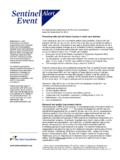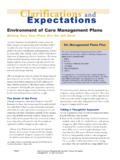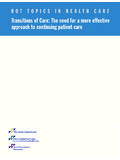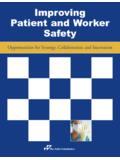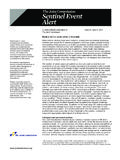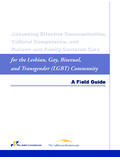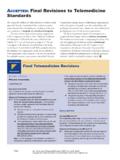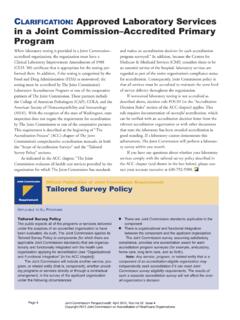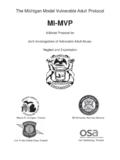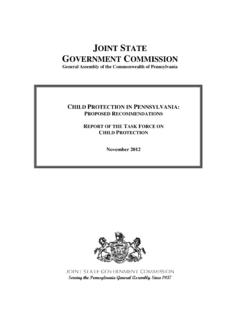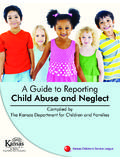Transcription of Physical and verbal violence against ... - Joint Commission
1 2018 The Joint Commission | Published by the Department of Corporate Communications What is workplace violence ? The CDC National Institute for Occupational Safety and Health (NIOSH) defines workplace violence as violent acts (including Physical assaults and threats of assaults) directed toward persons at work or on The Department of Labor defines workplace violence as an action ( verbal , written, or Physical aggression) which is intended to control or cause, or is capable of causing, death or serious bodily injury to oneself or others, or damage to property. Workplace violence includes abusive behavior toward authority, intimidating or harassing behavior, and A complimentary publication of The Joint Commission Issue 59, April 17, 2018 Revised: June 18, 2021 (in red) Physical and verbal violence against health care workers I ve been bitten, kicked, punched, pushed, pinched, shoved, scratched, and spat upon, says Lisa Tenney, RN, of the Maryland Emergency Nurses Association.
2 I have been bullied and called very ugly names. I ve had my life, the life of my unborn child , and of my other family members threatened, requiring security escort to my car. 1 Situ ations such as these describe some of the types of violence directed toward health care workers. Workplace violence is not merely the heinous, violent events that make the news; it is also the everyday occurrences, such as verbal abuse , that are often over looked. While this Sentinel Event Alert focuses on Physical and verbal violence , there is a whole spectrum of overlapping behaviors that undermine a culture of safety, addressed in Sentinel Event Alert issues 40 and 57;2,3 those types of behaviors will not be addressed in this alert. The focus of this alert is to help your organization recognize and acknowledge workplace violence directed against health care workers from patients and visitors, better prepare staff to handle violence , and more effectively address the aftermath.
3 Each episode of violence or credible threat to health care workers warrants notification to leadership, to internal security and, as needed, to law enforcement, as well as the creation of an incident report, which can be used to analyze what happened and to inform actions that need to be taken to minimize risk in the future. Under The Joint Commission s Sentinel Event policy, rape, assault (leading to death, permanent harm, or severe temporary harm), or homicide of a patient, staff member, licensed independent practitioner, visitor, or vendor while on site at an organization is a sentinel event that warrants a comprehensive systematic analysis. While the policy does not include other forms of violence , it is up to every organization to specifically define acceptable and unacceptable behavior and the severity of harm that will trigger an investigation.
4 The Centers for Disease Control and Prevention (CDC) National Institute for Occupational Safety and Health (NIOSH) defines workplace violence as violent acts (including Physical assaults and threats of assaults) directed toward persons at work or on duty. 4 The Department of Labor defines workplace violence as an action ( verbal , written, or Physical aggression) which is intended to control or cause, or is capable of causing, death or serious bodily injury to oneself or others, or damage to property. Workplace violence includes abusive behavior toward authority, intimidating or harassing behavior, and Published for Joint Commission accredited organizations and interested health care professionals, Sentinel Event Alert identifies specific types of sentinel and adverse events and high risk conditions, describes their common underlying causes, and recommends steps to reduce risk and prevent future occurrences.
5 Accredited organizations should consider information in a Sentinel Event Alert when designing or redesigning processes and consider implementing relevant suggestions contained in the alert or reasonable alternatives. Please route this issue to appropriate staff within your organization. Sentinel Event Alert may be reproduced if credited to The Joint Commission . To receive by email, or to view past issues, visit Sentinel Event Alert, Issue 59 Page 2 2018 The Joint Commission Although most incidents of workplace violence in health care are verbal in nature, other incidents involve assault, battery, domestic violence , stalking, and sexual The most common type of violence in health care is patient/visitor to ,8 A 2014 survey on hospital crime attributed 75 percent of aggravated assaults and 93 percent of all assaults against health care workers to patients or Prevalence of workplace violence in health care According to the Occupational Safety and Health Administration (OSHA)
6 , approximately 75 percent of nearly 25,000 workplace assaults reported annually occurred in health care and social service settings10 and workers in health care settings are four times more likely to be victimized than workers in private The National Crime Victimization Survey showed health care workers have a 20 percent higher chance of being the victim of workplace violence than other Bureau of Labor Statistics (BLS) data show that violence -related injuries are four times more likely to cause health care workers to take time off from work than other kinds of The Joint Commission s Sentinel Event data show 68 incidents of homicide, rape, or assault of hospital staff members over an eight-year period.* Alarmingly, the actual number of violent incidents involving health care workers is likely much higher because reporting is voluntary.
7 Researchers at Michigan State University estimated that the actual number of reportable injuries caused by workplace violence , according to Michigan state databases, was as much as three times the number reported by the BLS,14 which does not record verbal Episodes of workplace violence of all categories are grossly ,16 Health care workers are sometimes uncertain what constitutes violence , because they often believe that their assailants are not responsible for their actions due to conditions affecting their mental Only 30 percent of nurses report incidents of workplace violence ;18 among emergency department physicians, the reporting rate is 26 Underreporting is due in part to thinking that violence is part of the job. 20 In addition, worker-to -worker verbal abuse in health care has been accepted too often, leading to thinking that workers must accept verbal abuse from patients, too.
8 _____ * The reporting of most sentinel events to The Joint Commission is voluntary and represents only a small proportion of actual events. Therefore, these data are not an epidemiologic data set and no conclusions should be drawn about the actual relative frequency of events or trends in events over time. Adding to the problem are the many ways that workplace injuries may be reported at health care organizations. Information about health care workers injured on the job whether punched by a patient or accidentally stuck by a needle may be reported into various databases rather than one integrated database. This makes it difficult to recognize the scope of a workplace violence problem, or to track the effectiveness of efforts to mitigate or prevent workplace violence . To improve tracking efforts, OSHA launched the Injury Tracking Application, a secure website where covered employers must submit their workplace injury and illness information, including acute injuries and illnesses, days away from work, restricted work activity, or job transfer (also known as Days Away, Restrictions and Transfers, or DART).
9 21,22 In May 2016, OSHA published a rule titled Improve Tracking of Workplace Injuries and Illnesses, with an original effective date of Jan. 1, 2017 that was extended to Dec. 1, OSHA is considering whether or not to publish a new standard to prevent workplace violence in health care and social assistance settings. The agency issued a public Request for Information on the extent and nature of workplace violence in the industry and the effectiveness and feasibility of methods used to prevent such violence . The comment period closed on April 6, It is important to note that employers are required to provide a place of employment that is free from recognized hazards that are causing or are likely to cause death or serious harm, under the General Duty Clause, Section 5(a)(1) of the Occupational Safety and Health Act of Contributing factors violence against health care workers occurs in virtually all settings, with the emergency department (ED)
10 And inpatient psychiatric settings having the most recorded ,25 The home care settin g presents particular challenges because this environment is less controlled than other health care Sixty-one percent of home care workers report workplace violence each Long-term residential care facilities for the aged, cognitively impaired and mentally ill patients present special There is very little research about other Virtually all types of health care professionals have been victims. Nurses and nurses aides, particularly those in emergency settings11,28 and in nursing homes with dementia units,29 have been victimized at the highest ,15,20,30 An American Nurses Sentinel Event Alert, Issue 59 Page 3 2018 The Joint Commission Association study found that over a three-year period, 25 percent of surveyed registered nurses and nursing students reported being physicall y assaulted by a patient or a patient s family member, and about half reported being Physicians, particularly emergency medicine physicians,11,20,29 and inpatient psychiatric workers20,32 also are frequently victimized.
